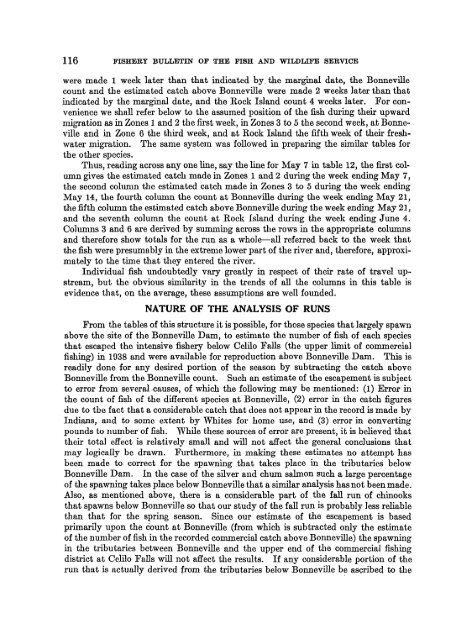Fishery bulletin of the Fish and Wildlife Service - NOAA
Fishery bulletin of the Fish and Wildlife Service - NOAA
Fishery bulletin of the Fish and Wildlife Service - NOAA
You also want an ePaper? Increase the reach of your titles
YUMPU automatically turns print PDFs into web optimized ePapers that Google loves.
116 FISHERY BULLETIN OP THE FISH AND WILDLIFE SEBVICE<br />
were made 1 week later than that indicated by. <strong>the</strong> marginal date, <strong>the</strong> Bonneville<br />
count <strong>and</strong> <strong>the</strong> estimated catch above Bonneville were made 2 weeks later than that<br />
indicated by <strong>the</strong> marginal date, <strong>and</strong> <strong>the</strong> Rock Isl<strong>and</strong> count 4 weeks later. For convenience<br />
we shall refer below to <strong>the</strong> assumed position <strong>of</strong> <strong>the</strong> fish during <strong>the</strong>ir upward<br />
migration as in Zones 1 <strong>and</strong> 2 <strong>the</strong> first week, in Zones 3 to 5 <strong>the</strong> second week, at Bonneville<br />
<strong>and</strong> in Zone 6 <strong>the</strong> third week, <strong>and</strong> at Rock Isl<strong>and</strong> <strong>the</strong> fifth week <strong>of</strong> <strong>the</strong>ir freshwater<br />
migration. The same system was followed in preparing <strong>the</strong> similar tables for<br />
<strong>the</strong> o<strong>the</strong>r species.<br />
Thus, reading across any one line, say <strong>the</strong> line for May 7 in table 12, <strong>the</strong> first column<br />
gives <strong>the</strong> estimated catch made in Zones 1 <strong>and</strong> 2 during <strong>the</strong> week ending May 7,<br />
<strong>the</strong> second column <strong>the</strong> estimated catch made in Zones 3 to 5 during <strong>the</strong> week ending<br />
May 14, <strong>the</strong> fourth column <strong>the</strong> count at Bonneville during <strong>the</strong> week ending May 21,<br />
<strong>the</strong> fifth column <strong>the</strong> estimated catch above Bonneville during <strong>the</strong> week ending May 21,<br />
<strong>and</strong> <strong>the</strong> seventh column <strong>the</strong> count at Rock Isl<strong>and</strong> during <strong>the</strong> week ending June 4.<br />
Columns 3 <strong>and</strong> 6 are derived by summing across <strong>the</strong> rows in <strong>the</strong> appropriate columns<br />
<strong>and</strong> <strong>the</strong>refore show totals for <strong>the</strong> run as a whole—all referred back to <strong>the</strong> week that<br />
<strong>the</strong> fish were presumably in <strong>the</strong> extreme lower part <strong>of</strong> <strong>the</strong> river <strong>and</strong>, <strong>the</strong>refore, approximately<br />
to <strong>the</strong> time that <strong>the</strong>y entered <strong>the</strong> river.<br />
Individual fish undoubtedly vary greatly in respect <strong>of</strong> <strong>the</strong>ir rate <strong>of</strong> travel upstream,<br />
but <strong>the</strong> obvious similarity in <strong>the</strong> trends <strong>of</strong> all <strong>the</strong> columns in this table is<br />
evidence that, on <strong>the</strong> average, <strong>the</strong>se assumptions are well founded.<br />
NATURE OF THE ANALYSIS OF RUNS<br />
From <strong>the</strong> tables <strong>of</strong> this structure it is possible, for those species that largely spawn<br />
above <strong>the</strong> site <strong>of</strong> <strong>the</strong> Bonneville Dam, to estimate <strong>the</strong> number <strong>of</strong> fish <strong>of</strong> each species<br />
that escaped <strong>the</strong> intensive fishery below Celilo Falls (<strong>the</strong> upper limit <strong>of</strong> commercial<br />
fishing) in 1938 <strong>and</strong> were available for reproduction above Bonneville Dam. This is<br />
readily done for any desired portion <strong>of</strong> <strong>the</strong> season by subtracting <strong>the</strong> catch above<br />
Bonneville from <strong>the</strong> Bonneville count. Such an estimate <strong>of</strong> <strong>the</strong> escapement is subject<br />
to error from several causes, <strong>of</strong> which <strong>the</strong> following may be mentioned: (1) Error in<br />
<strong>the</strong> count <strong>of</strong> fish <strong>of</strong> <strong>the</strong> different species at Bonneville, (2) error in <strong>the</strong> catch figures<br />
due to <strong>the</strong> fact that a considerable catch that does not appear in <strong>the</strong> record is made by<br />
Indians, <strong>and</strong> to some extent by Whites for home use, aod (3) error in converting<br />
pounds to number <strong>of</strong> fish. While <strong>the</strong>se sources <strong>of</strong> error are present, it is believed that<br />
<strong>the</strong>ir total effect is relatively small <strong>and</strong> will not affect <strong>the</strong> general conclusions that<br />
may logically be drawn. Fur<strong>the</strong>rmore, in making <strong>the</strong>se estimates no attempt has<br />
been made to correct for <strong>the</strong> spawning that takes place in <strong>the</strong> tributaries below<br />
Bonneville Dam. In <strong>the</strong> case <strong>of</strong> <strong>the</strong> silver <strong>and</strong> chum salmon such a large percentage<br />
<strong>of</strong> <strong>the</strong> spawning takes place below Bonneville that a similar analysis has not been made.<br />
Also, as mentioned above, <strong>the</strong>re is a considerable part <strong>of</strong> <strong>the</strong> fall run <strong>of</strong> chinooks<br />
that spawns below Bonneville so that our study <strong>of</strong> <strong>the</strong> fall run is probably less reliable<br />
than that for <strong>the</strong> spring season. Since our estimate <strong>of</strong> <strong>the</strong> escapement is based<br />
primarily upon <strong>the</strong> count at Bonneville (from which is subtracted only <strong>the</strong> estimate<br />
<strong>of</strong> <strong>the</strong> number <strong>of</strong> fish in <strong>the</strong> recorded commercial catch above Bonneville) <strong>the</strong> spawning<br />
in <strong>the</strong> tributaries between Bonneville <strong>and</strong> <strong>the</strong> upper end <strong>of</strong> <strong>the</strong> commercial fishing<br />
district at Celilo Falls will not affect <strong>the</strong> results. If any considerable portion <strong>of</strong> <strong>the</strong><br />
run that is actually derived from <strong>the</strong> tributaries below Bonneville be ascribed to <strong>the</strong>

















